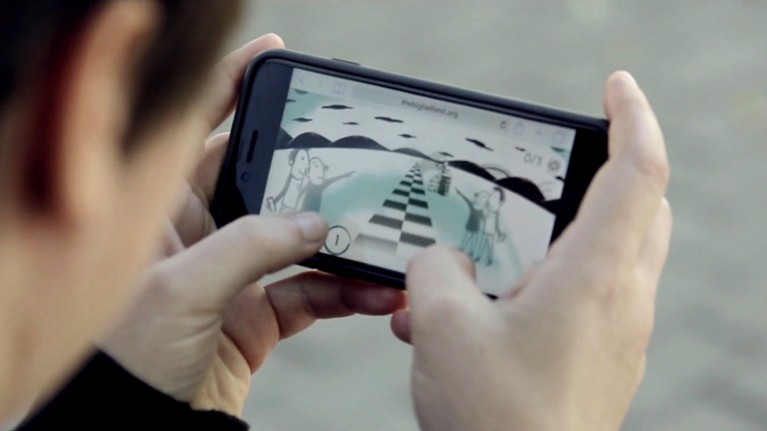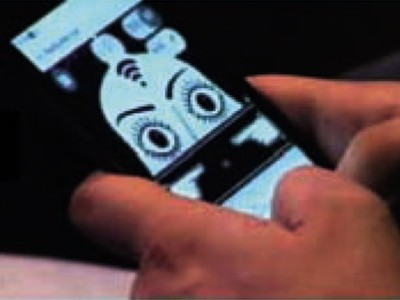
0 or 1? Computer gamers have helped to close a quantum loophole.Credit: ICFO
Wednesday, 30 November 2016, saw crowds of Cubans line the streets of Havana to say a final farewell to Fidel Castro. On the same day, fans gathered to watch Spanish football minnows Hércules hold giants Barcelona to a surprise one-all draw in their Copa del Rey tie. And a crowd of 100,000 people around the world came together over an online video game to type in a series of 0s and 1s as fast as their fingers could fly, to put to the test a central feature of quantum mechanics.
The gamers were part of a day-long experiment called the BIG Bell Test, the results of which are described in this issue of Nature (The BIG Bell Test Collaboration. Nature 557, 212–216; 2018). The findings were produced in an unusual way and, with the symmetry that one would expect from a beautiful physics theory, they were reviewed for publication in an unusual way, too.
Challenging local realism with human choices
Less than a year after the test, the BIG Bell Test paper landed for review from Nature on the desk of Sabrina Maniscalco, a physicist at the University of Turku in Finland. Seeing the crowdsourced public input it contained, Maniscalco decided to crowdsource the requested review — well, up to a point. She showed it to seven of her senior PhD students, and then invited them to discuss it with her over a day of brainstorming, literature search and pizza. She channelled the resulting comments and criticisms into the referee’s report that she submitted, and which all seven students saw again before submission. No confidence was breached during the review process: the students agreed to strict confidentiality, and Maniscalco opted in to our referee-accreditation trial scheme, which means that her name, together with those of the participating students, appears in a statement at the end of the research paper. Two other reviewers offered their thoughts on the paper in the usual way.
It is not unusual for a lab head to delegate a paper’s peer review to a junior colleague, or to collaborate with one — and, unfortunately, the colleague’s contribution isn’t always acknowledged. It is unusual, as far as we know, to make peer review a team exercise and to openly state that that was how it was done. It’s not an experiment we expect will be repeated often. Still, contrary to popular belief, our editors are, in principle, happy for referees to involve others in the review process, as long as confidentiality is assured and the editors are kept in the loop. It’s right for all those involved in peer review to be acknowledged. At its best, such collaboration can enrich the review process and help junior researchers develop the skills needed to become effective referees themselves.
In this case, the paper explores the tension between quantum physics and local realism. The latter brings together two principles: locality — according to which, observing a particle at one physical location cannot have immediate effects on the properties of a particle at a different location — and realism, which expresses how the observable features of particles exist even if we don’t actively measure them. But in quantum mechanics, correlations between distant particles exist that are so strong they violate local realism. Put differently, in quantum theory it is possible to have two correlated particles far away from each other, to measure the first and, as a result, learn something about the second without having observed it directly.
So here’s the conundrum: does quantum mechanics really violate local realism, or could it be the case that some unknown factors would complete the theory and explain these apparent violations? In the 1960s, the physicist John Bell offered a way to tackle the problem in the laboratory, by studying quantum correlations in the form of entanglement. In these experiments, sequences of spatially separated measurements on entangled particles lead to computing a quantity that can have values not possible in the context of local and realistic theories. Bell tests have confirmed the validity of quantum theory many times, but they include assumptions that leave wiggle room for non-quantum explanations as to why local realism is violated, and so physicists have been looking for ways to close these loopholes ever since.
In 2015, physicists showed that successful Bell tests could not be due to speed-of-light communication between the particles, or to inefficient detection processes during the measurements. But another, more subtle, loophole was still open. Bell tests also assume that experimenters have free choice over which measurements they make on each particle. And yet, hidden parameters could be influencing these choices to produce correlations that give the illusion of entanglement.
The BIG Bell Test closes this freedom-of-choice loophole. The various experimental groups had no say in which measurement settings to use. Instead, they performed their measurements according to the unpredictable streams of bits received from the 100,000 gamers.
The results show the presence of correlations strong enough to contradict local realism. Maybe that’s how 30 November 2016 might be remembered: the day the people of the world came together to test quantum theory.

 Challenging local realism with human choices
Challenging local realism with human choices
 Cosmic test backs ‘quantum spookiness’
Cosmic test backs ‘quantum spookiness’


